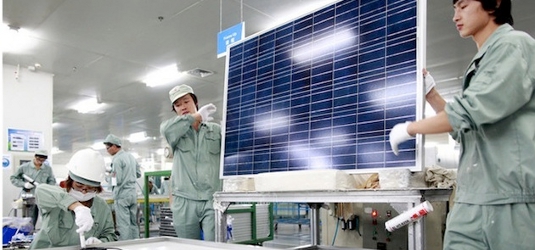Another day, another efficiency record broken. This time an aperture efficiency record for multicrystalline silicon solar modules, thus it only covers a certain area of the module, but it is still moving in the right direction. Trina Solar is responsible for the broken record, with its “Honey Plus” module, which use half-cell interconnection and PERC technology during the manufacturing process.
The 19.86% aperture efficiency was set across a module area of 1.514 m2, on a module that contained 120 pieces of P-type multicrystalline silicon solar cells. The record was set at Trina’s State Key Laboratory of PV Science and Technology of China, and was verified by the Fraunhofer ISE CalLab in Germany.
Interestingly, the new efficiency broke the previous record of 19.14%, that was set back in April 2015, so it shows a dramatic improvement.
“The efficiency of PV modules is one of the key parameters to estimate the final Levelised Cost of solar Electricity,” commented Trina Solar Vice-President and chief scientist Pierre Verlinden. “This 19.86% aperture efficiency result that Trina Solar achieved demonstrates the huge potential for future multicrystalline p-type silicon research. It is also a leap forward in the trend of continuous efficiency improvements of crystalline silicon solar modules. In the innovation-driven PV industry, Trina Solar is always focused on developing leading-edge PV technologies and products that improve cell efficiency and reduce system cost.”
The current aperture efficiency world record for HIT technology modules is 23.8%, set by Panasonic back in March 2016. The monocrystalline efficiency record is currently held by SunPower, with an efficiency of 25.0%.
This content is protected by copyright and may not be reused. If you want to cooperate with us and would like to reuse some of our content, please contact: editors@pv-magazine.com.









By submitting this form you agree to pv magazine using your data for the purposes of publishing your comment.
Your personal data will only be disclosed or otherwise transmitted to third parties for the purposes of spam filtering or if this is necessary for technical maintenance of the website. Any other transfer to third parties will not take place unless this is justified on the basis of applicable data protection regulations or if pv magazine is legally obliged to do so.
You may revoke this consent at any time with effect for the future, in which case your personal data will be deleted immediately. Otherwise, your data will be deleted if pv magazine has processed your request or the purpose of data storage is fulfilled.
Further information on data privacy can be found in our Data Protection Policy.